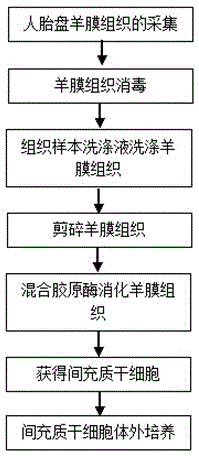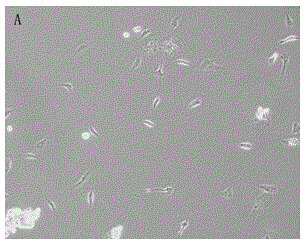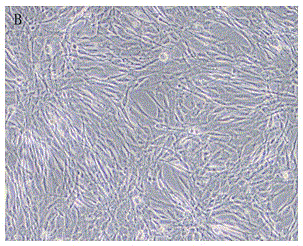Isolated culture method of human amnia mesenchymal stem cells
A technique for isolating and culturing stem cells, applied in the field of biomedicine, can solve the problems of long culture period, low cell viability, low cell purity, etc., and achieve the effects of uniform and stable phenotype, strong proliferation ability, and short culture period.
- Summary
- Abstract
- Description
- Claims
- Application Information
AI Technical Summary
Problems solved by technology
Method used
Image
Examples
Embodiment 1
[0037] see Figure 1-8 , in an embodiment of the present invention, a method for isolating and culturing human amniotic mesenchymal stem cells, comprising the following steps:
[0038] 1. Preparation of mesenchymal stem cells
[0039] (1) Collection of human placenta and amniotic membrane tissue: After the human placenta is removed, it is immersed in the placenta preservation solution and kept at 2-8°C for no more than 24 hours.
[0040] (2) Disinfection of amniotic membrane tissue: Take the placenta out of the placental preservation solution, place it flat on a sterile tray with the side containing the amniotic membrane tissue facing up, wipe it clockwise with 75% alcohol cotton, repeat twice, and start from the placenta with the umbilical cord as the The sterilized amniotic tissue was stripped centrally.
[0041](3) Washing: Put the amnion tissue into a 90cm sterile petri dish, wash it twice with tissue sample washing solution, with an interval of 5 minutes, and then wash ...
PUM
 Login to View More
Login to View More Abstract
Description
Claims
Application Information
 Login to View More
Login to View More - R&D
- Intellectual Property
- Life Sciences
- Materials
- Tech Scout
- Unparalleled Data Quality
- Higher Quality Content
- 60% Fewer Hallucinations
Browse by: Latest US Patents, China's latest patents, Technical Efficacy Thesaurus, Application Domain, Technology Topic, Popular Technical Reports.
© 2025 PatSnap. All rights reserved.Legal|Privacy policy|Modern Slavery Act Transparency Statement|Sitemap|About US| Contact US: help@patsnap.com



